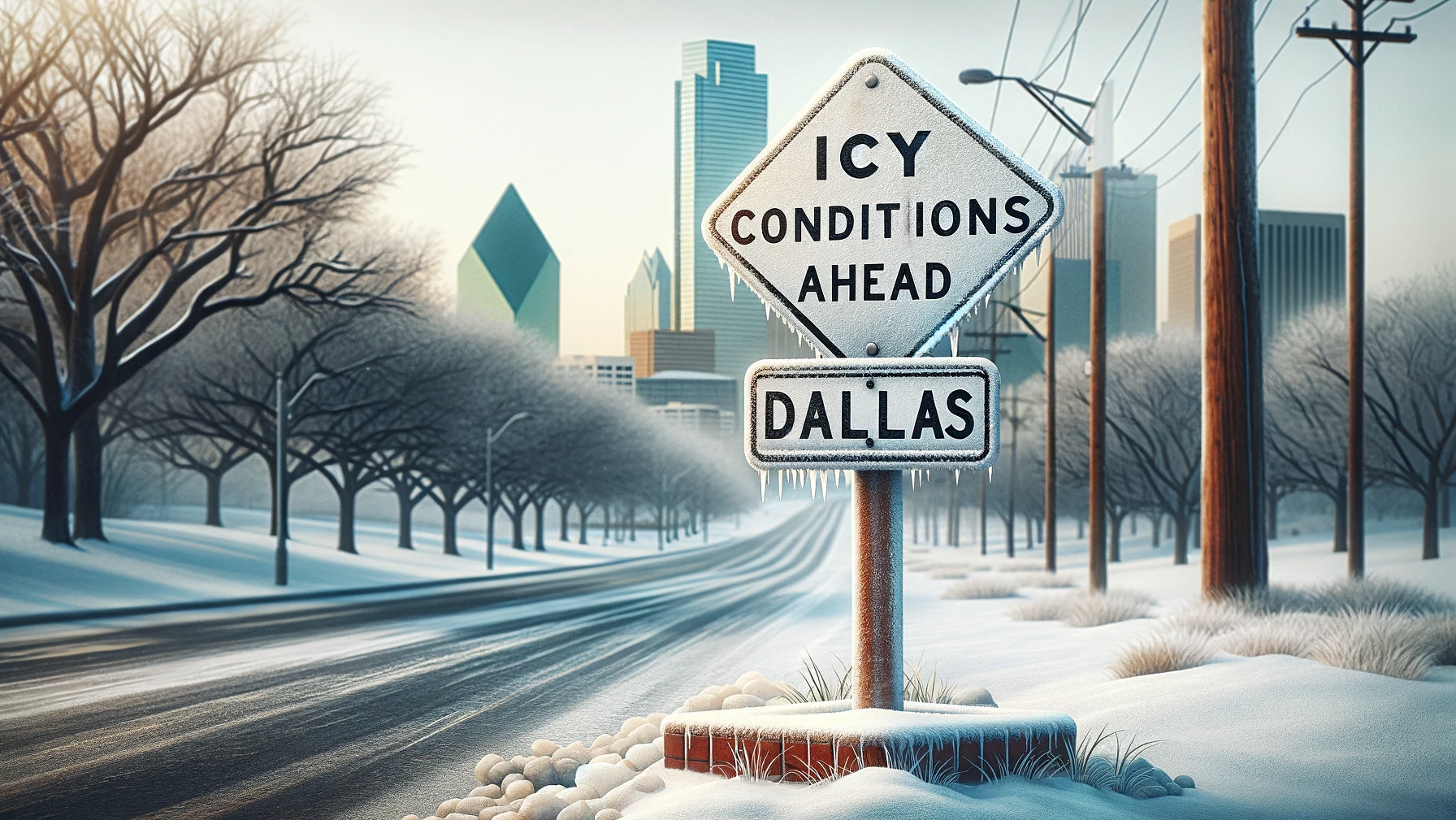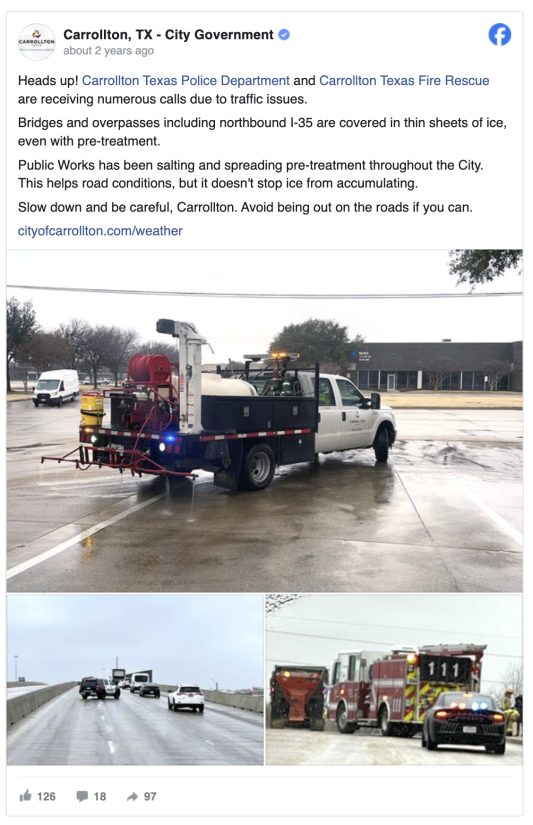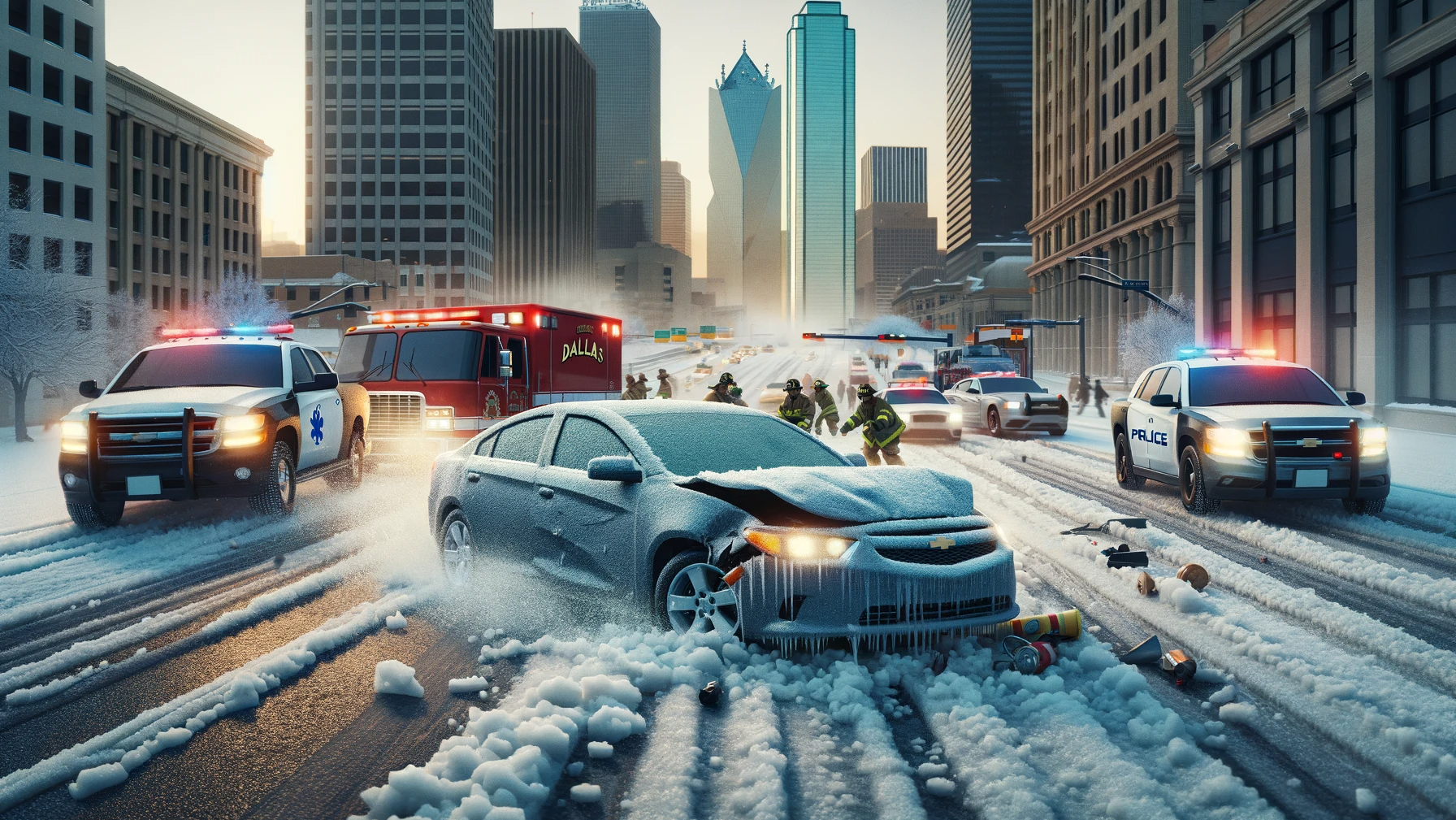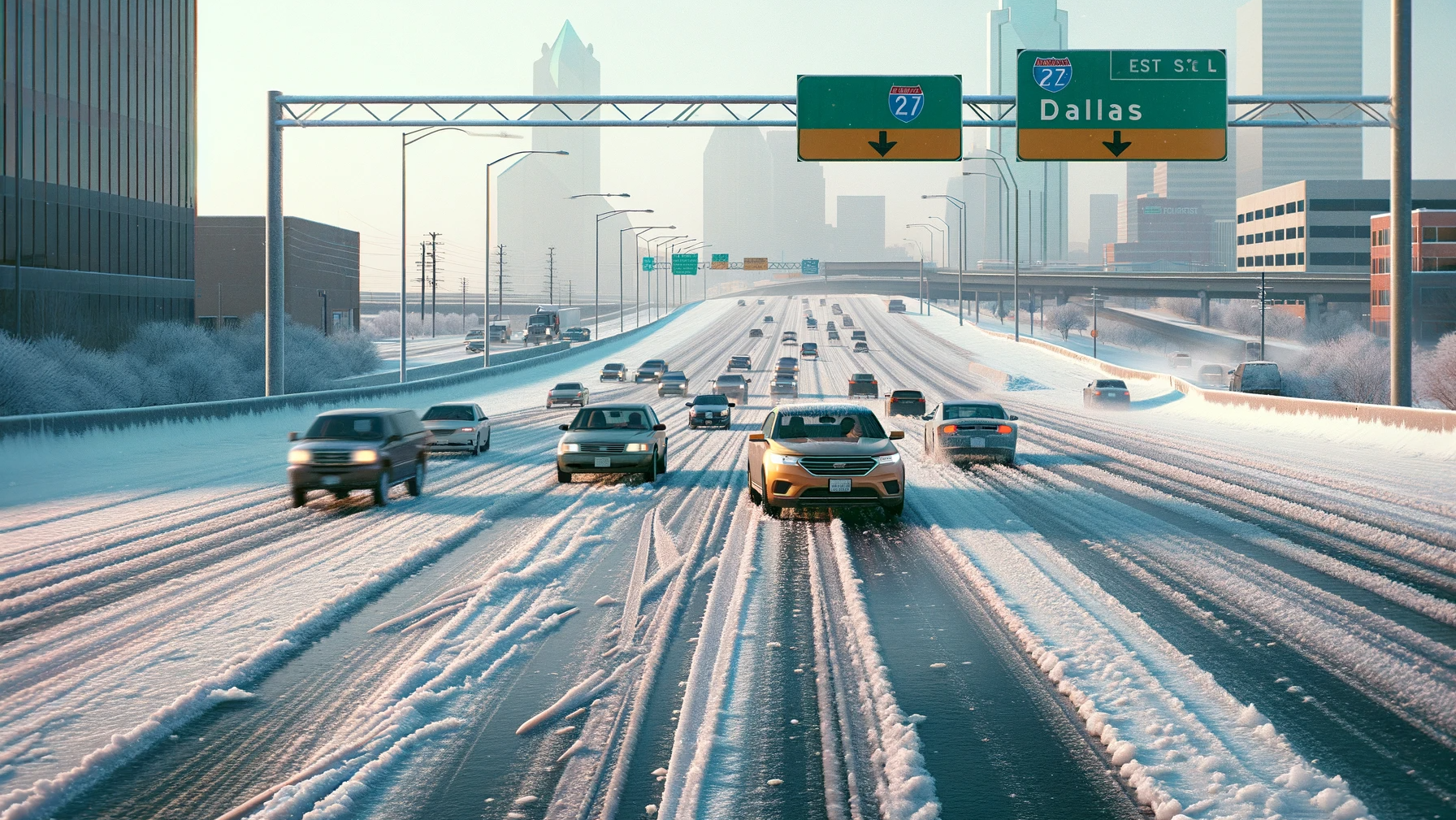11 Dangerous Icy Road Spots in DFW (2024)
January 12, 2024

Icy roads in Dallas present a real danger, especially during winter months. When Dallas roads froze in 2023, the city witnessed 160 car crashes in just 8 hours due to black ice. This highlights the unpredictable and dangerous nature of icy conditions in the city.
This guide aims to equip you with vital information for navigating Dallas’s icy roads and advise on handling accidents.
Here’s an overview:
- Key Takeaways
- High-Risk Icy Road Spots in Dallas
- Bedford: Dangerous Icy Road: S.H. 183 West Bound Toll Lanes
- Carrollton: Northbound I-35 Bridges
- Colleyville: Bridge in the 4500 block of Bedford Road
- Dallas: IH-635 (Lyndon B. Johnson Freeway)
- Denton: Eastbound U.S. 380 near Rockhill Road
- Fort Worth: IH-30 at Linkcrest Drive
- Grapevine: S.H. 121 Bridges
- Keller: S.H. 114 Bridges
- McKinney: U.S. 380 and FM 3286
- Allen: Stacy Road
- The Aftermath of an Icy Road Accident
- Understanding Personal Injury Claims in Dallas
- Building Your Personal Injury Case After an Icy Road Accident
- Navigating the Legal Process After an Icy Road Accident
- Tips for Safe Driving on Dallas’s Icy Roads
Key Takeaways
- Elevated Structures Are More Prone to Icing: Bridges and overpasses, such as those on S.H. 114 in Keller and Grapevine, freeze more quickly and are especially dangerous in icy conditions.
- High Traffic Increases Risk: Areas with high traffic volume, like IH-635 in Dallas and U.S. 380 in McKinney, see increased accidents during icy conditions due to the combination of slippery roads and heavy vehicle flow.
- Speed Limit Factors: High-speed limits, typical on freeways and toll roads, contribute to the severity and frequency of accidents on icy roads.
- Accident Hotspots: Specific locations, such as the S.H. 183 West Bound Toll Lanes in Bedford and the intersection at Stacy Road in Allen, are known hotspots for ice-related accidents.
- Importance of Caution and Preparedness: Drivers need to exercise extreme caution, especially in known high-risk areas, and stay informed about the latest road and weather conditions to avoid accidents.
High-Risk Icy Road Spots in Dallas

Navigating Dallas roads during icy conditions can be treacherous. Based on recent data, here are some areas in Dallas known for being particularly hazardous in icy conditions:
Bedford: Dangerous Icy Road: S.H. 183 West Bound Toll Lanes
The Bedford S.H. 183 West Bound Toll Lanes are known to be dangerous in icy conditions. This roadway, a toll lane in Bedford, Texas, has witnessed serious accidents, particularly when icy. The combination of high-speed limits and heavy traffic contributes to its riskiness. In icy conditions, these factors make it more challenging for drivers to control their vehicles, leading to higher accident rates.
A notable incident involved a two-vehicle crash that resulted in serious injuries, emphasizing the perilous nature of this road spot during icy weather. The area between the Central Drive and Bedford Road exits, in particular, seems to be a hotspot for such incidents.
Carrollton: Northbound I-35 Bridges
The Northbound I-35 Bridges in Carrollton, Texas, are particularly hazardous in icy conditions. This stretch, known for high traffic volumes and speed, becomes treacherous when ice forms. The bridges, including overpasses, are prone to icing faster than regular road surfaces due to their elevated structure and exposure to cold air above and below. This makes them slippery, increasing the risk of accidents.
In Carrollton, icy conditions have led to multiple traffic issues and accidents, as detailed in a WFAA report here, emphasizing the need for extra caution on these bridges during winter.

Colleyville: Bridge in the 4500 block of Bedford Road
The bridge in the 4500 block of Bedford Road in Colleyville becomes highly treacherous in icy conditions. This area, as reported by the Colleyville Police Department, experiences complete icing over during winter storms, making it extremely slippery and dangerous for drivers.
The risk is exacerbated due to its location north of Little Bear Creek, where colder temperatures can lead to quicker ice formation. The bridge’s structure, combined with potentially high traffic volumes, significantly increases the likelihood of accidents in icy weather.
Dallas: IH-635 (Lyndon B. Johnson Freeway)
IH-635, also known as the Lyndon B. Johnson Freeway, is a major roadway in Dallas, Texas. This freeway is known for:
- High Traffic Volume:
- As one of Dallas’s busiest highways, IH-635 often experiences heavy traffic.
- High traffic volume can lead to more accidents, especially in icy conditions.
- Elevated Sections:
- The freeway includes elevated sections and interchanges, like the High Five Interchange.
- Elevated roads freeze more quickly than ground-level roads.
- Speed Limits:
- The freeway’s speed limits, typical for major highways, can be dangerous when roads are icy.
- Higher speeds make it harder to control vehicles on ice.
In icy conditions, these factors combine to make IH-635 particularly dangerous. Drivers may not anticipate the sudden appearance of ice, especially on elevated sections, leading to a higher risk of accidents. It’s crucial to drive cautiously and be aware of changing road conditions during winter weather in Dallas.
Denton: Eastbound U.S. 380 near Rockhill Road
The Eastbound U.S. 380 near Rockhill Road in Denton, Texas, is particularly dangerous in icy conditions. Elevated road surfaces like this part of U.S. 380 are prone to rapid icing, making them hazardous for drivers, especially at high speeds and in heavy traffic. Such conditions increase the likelihood of multi-vehicle accidents, as evidenced in the reported incident.
Fort Worth: IH-30 at Linkcrest Drive
The Interstate 30 at Linkcrest Drive in Fort Worth is notably hazardous during icy conditions. This area, being a part of a major highway, typically experiences high traffic, compounding the risk during icy weather. The elevated sections and overpasses on this route are prone to quick ice formation, making the roadway slippery and dangerous.
Such conditions increase the likelihood of accidents, as seen in a reported incident involving multiple 18-wheelers. The high speed limit typical for interstates like I-30 also contributes to the danger, as it becomes more challenging for vehicles to maintain control on ice.
Grapevine: S.H. 121 Bridges
The S.H. 121 Bridges in Grapevine are particularly dangerous during icy conditions. This is due to their elevated structure, making them prone to rapid ice formation. Heavy traffic and high speeds on these bridges further increase the risk of accidents when they are icy. A significant issue reported in the area was that despite pre-treatment efforts, bridges and overpasses, including those on S.H. 121, were covered in thin sheets of ice, leading to hazardous driving conditions.
Keller: S.H. 114 Bridges
The S.H. 114 Bridges in Keller are notably dangerous in icy conditions. This is highlighted by an incident reported by WFAA where a Keller police officer’s vehicle was struck by another car that lost control on an icy spot on the highway. The bridges on S.H. 114 are high-traffic areas with significant vehicle speeds, and their elevated nature makes them particularly prone to icing. This combination of factors – high speeds, heavy traffic, and rapid ice formation on the bridges – greatly increases the risk of accidents during icy weather.
McKinney: U.S. 380 and FM 3286
The area around U.S. 380 and FM 3286 in McKinney, Texas, becomes highly dangerous during icy conditions. This region experienced significant disruptions due to winter weather, with a major incident involving an eight-vehicle crash. The combination of the road’s high traffic volume and the quick ice formation on the bridge at this location contributed to the hazardous conditions. Elevated roadways like bridges are particularly prone to icing, making them slippery and increasing the risk of multi-vehicle accidents.
Allen: Stacy Road
Stacy Road in Allen, Texas, becomes particularly dangerous in icy conditions due to several factors. It is a busy road that intersects with U.S. 75, a major highway. This intersection area sees heavy traffic, increasing the risk of accidents when the road is icy. The elevated structure of the overpass at this intersection is prone to rapid ice formation.
A notable accident occurred involving an 18-wheeler truck on U.S. 75 near Stacy Road, demonstrating the risks in such icy conditions. The combination of heavy traffic, high speeds, and the propensity for ice formation on the overpass makes this area particularly treacherous during winter weather events.
The Aftermath of an Icy Road Accident

When you’re in a car crash on icy roads in Dallas, your actions right after the accident are crucial. Here’s what you need to do:
- Check for Injuries:
- First, make sure you and any passengers are okay.
- Call 911 if anyone is hurt.
- Move to Safety:
- If you can, move your car to the side of the road.
- Turn on your hazard lights to warn other drivers.
- Call the Police:
- Even in minor crashes, it’s vital to have a police report.
- The report will be key in your injury claim later.
- Document the Accident:
- Take pictures of the scene, including ice patches, car positions, and damage.
- Note the time, location, and weather conditions.
- Exchange Information:
- Get names, contact details, and insurance info from all drivers involved.
- Don’t discuss who is at fault.
- Look for Witnesses:
- If anyone saw the crash, get their contact info.
- Their statements can support your claim.
- Notify Your Insurance Company:
- Tell them about the accident as soon as possible.
- Be factual but don’t admit fault.
- Seek Medical Attention:
- Go to a doctor even if you feel fine.
- Injuries from car crashes can show up later.
- Keep Records:
- Document any lost work days or other impacts on your life.
- Save all medical bills, repair receipts, and any other expenses related to the accident.
Remember, ice-related accidents in Dallas can be complex. The roads might look safe, but black ice can catch drivers off guard. This is why documenting everything is so critical. It proves the conditions at the time of your accident.
Your next step will be understanding how to navigate the personal injury claim process in Dallas. This will include knowing the local laws, assessing your damages, and possibly seeking legal help. I’ll guide you through these steps in the upcoming sections.
Understanding Personal Injury Claims in Dallas

After an icy road accident in Dallas, knowing how to navigate a personal injury claim is vital. Texas laws can be complex, but I’ll break them down for you. Here’s what you need to understand:
- Texas Personal Injury Laws:
- Texas follows a “modified comparative fault” system.
- This means you can still recover damages even if you’re partly at fault.
- However, your compensation is reduced by your percentage of fault.
- You can’t claim if you’re more than 50% at fault.
- Statute of Limitations:
- In Texas, you have two years from the date of the accident to file a claim.
- Missing this deadline can mean losing your right to compensation.
- Dealing with Insurance Companies:
- Be cautious when speaking with insurance adjusters.
- They often aim to minimize payouts.
- Do not agree to any settlement without understanding its full impact.
- Determining Fault in Ice-Related Accidents:
- Fault can be tricky in accidents caused by icy roads.
- It often comes down to who was driving recklessly for the conditions.
- Evidence like weather reports and photos from the scene is crucial.
- Seeking Legal Advice:
- A Dallas-based personal injury lawyer can help navigate these complexities.
- They can assess the strength of your claim.
- They’ll also guide you on the best course of action.
Understanding these aspects is key to successfully pursuing a personal injury claim in Dallas. Especially in ice-related accidents, proving negligence and fault requires specific knowledge of local laws and conditions. It’s often in your best interest to consult with a lawyer who has experience in such cases.
In the next section, I’ll dive into how to build your personal injury case. This includes collecting evidence, calculating your damages, and why choosing a local Dallas lawyer is crucial for your case.
Building Your Personal Injury Case After an Icy Road Accident

Building a strong personal injury case after an icy road accident in Dallas involves careful preparation and attention to detail. I’ll guide you through the key steps to gather the necessary evidence and calculate your damages. This process is crucial for a successful claim.
- Gathering Evidence:
- Take photos of the accident scene, vehicle damage, and any visible injuries.
- Collect names and statements from witnesses.
- Obtain a copy of the police report and any relevant traffic camera footage.
- Keep a record of weather conditions at the time of the accident.
- Medical Records and Expenses:
- Document all medical treatments related to the accident.
- Include hospital bills, prescription costs, and therapy expenses.
- Keep a detailed record of your recovery process.
- Lost Wages and Work Impact:
- Calculate any lost income due to the accident.
- This includes missed work days and potential future income loss.
- Obtain a letter from your employer verifying your missed work.
- Pain and Suffering:
- Document how the accident has affected your daily life.
- Include notes on pain levels, mental anguish, and lifestyle changes.
- This information can support a claim for non-economic damages.
- Hiring a Dallas-Based Injury Lawyer:
- A local lawyer will understand Dallas’s specific legal landscape.
- They can provide tailored advice based on your situation.
Remember, the strength of your personal injury case largely depends on the quality and quantity of the evidence you collect.
Be thorough and consistent in documenting every aspect of the accident and its aftermath. In the next section, I’ll discuss navigating the legal process, including dealing with insurance companies and what to expect in settlement negotiations or at trial. This knowledge will further empower you in your pursuit of fair compensation.
Navigating the Legal Process After an Icy Road Accident

Navigating the legal process in a personal injury case, especially after an ice-related car accident in Dallas, can be daunting. I’m here to guide you through this journey, ensuring you understand each step. Let’s break down what you can expect.
- Filing Your Claim:
- Start by filing a claim with the at-fault party’s insurance company.
- Include all evidence you’ve gathered: photos, medical records, and a copy of the police report.
- Clearly state your injuries and the damages you’re seeking.
- Dealing with Insurance Companies:
- Be prepared for negotiations with insurance adjusters.
- They may offer a quick settlement, often lower than what you deserve.
- Consult your lawyer before accepting any offer.
- The Role of Your Lawyer:
- Your lawyer will handle communications and negotiations on your behalf.
- They will aim for a fair settlement without going to court.
- If necessary, they will prepare your case for trial.
- Settlement Negotiations:
- Most personal injury cases settle before reaching court.
- Settlement involves negotiating a fair compensation amount with the insurer.
- Your lawyer will advise you on whether to accept a settlement offer.
- Going to Trial:
- If a settlement isn’t reached, your case may go to trial.
- Trials can be lengthy and require detailed preparation.
- Your lawyer will present your case, aiming to show the other party’s fault and your damages.
- Receiving Your Compensation:
- Once a settlement or court verdict is reached, you’ll receive your compensation.
- This can cover medical expenses, lost wages, and pain and suffering.
- Your lawyer will ensure the funds are properly distributed.
Throughout this process, remember the importance of patience and thorough preparation. Personal injury claims, particularly those involving car accidents on icy roads, require clear evidence and strong legal strategy. By understanding each step and working closely with your lawyer, you maximize your chances of a favorable outcome.
In the following section, I will provide tips for safe driving on Dallas’s icy roads. This advice can help you avoid future accidents and ensure your safety during the unpredictable Texas winter.
Tips for Safe Driving on Dallas’s Icy Roads
Driving on icy roads in Dallas can be challenging and dangerous. To help you stay safe, I’ve compiled essential tips for navigating these tricky conditions. Following these guidelines can reduce your risk of accidents during winter.
- Prepare Your Vehicle:
- Check your tires for proper tread and pressure.
- Ensure your brakes and lights are working correctly.
- Keep your windshield and windows clear for good visibility.
- Driving Techniques:
- Drive slowly and increase your following distance.
- Avoid sudden stops and sharp turns.
- Use gentle acceleration to prevent skidding.
- Handling Skids:
- If you start to skid, don’t panic.
- Steer gently in the direction you want to go.
- Avoid slamming on the brakes.
- Plan Your Route:
- Choose roads that are more likely to have been treated for ice.
- Avoid hills and exposed areas where ice forms easily.
- Stay informed about current road conditions.
- What to Do in a Skid:
- Ease off the gas pedal.
- Carefully steer in the direction you want the front of the car to go.
- If you have anti-lock brakes, apply firm, steady pressure. If not, pump the brakes gently.
- Emergency Kit:
- Keep a winter emergency kit in your car.
- Include items like blankets, a flashlight, water, and a first-aid kit.
- Have a phone charger and emergency contact numbers handy.
- Stay Informed:
- Check weather forecasts and road conditions before heading out.
- Consider postponing your trip if severe weather is expected.
- Stay updated on the latest weather changes while on the road.
These tips can make a significant difference in your safety while driving on icy Dallas roads. For more comprehensive advice and the latest road safety updates, visit the Texas Department of Transportation website here.
By being prepared and cautious, you can navigate Dallas’s winter roads more safely, reducing the likelihood of accidents. In the next section, I’ll conclude with final thoughts on staying safe and protecting your rights after an icy road accident in Dallas.